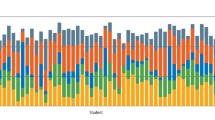Abstract
Design A randomised blinded crossover trial.
Sample selection Forty local primary care dentists in the south west of England were recruited using a variety of methods. Dentists from NHS, mixed practice, private practice and community services were included. Participants were allocated to four balanced experimental test groups of equal numbers. Block randomisation was used for allocation. The principle researcher was blind to which group a participant was from. The trial was completed using a purpose-made weblink which contained a clinical decision-making exercise. The participants repeated the exercise under increasing time pressure.
Data analysis Data analysis was performed independently by the principle researcher. The diagnostic sensitivity and specificity of the decisions made were calculated and statistical analysis preformed. This included paired t-tests to assess differences in self-reported stress and difficulty when the exercise was performed under different time constraints. Mann-Whitney U tests were used to compare differences in the sensitivity and specificity values achieved under the varying time constraints.
Results One hundred percent (n = 40) of GDPs who responded to the invitation were eligible and included in the study. Results showed a statistical difference (p <0.001) of both perceived difficulty of the task, and stress experienced when under time pressure. Results showed diagnostic sensitivity to pathological features was significantly worse (p <0.001) under time pressure. Conversely, the specificity of identification of pathology free sites were not affected by the different circumstances.
Conclusions Time pressure negatively impacted diagnostic performance and decreased diagnostic sensitivity for all pathological features. Sensitivity to caries-related pathology and periodontal disease-related pathology deteriorated by 40% and 67%, retrospectively.
Similar content being viewed by others
A Commentary on
Plessas A, Nasser M, Hanoch Y, O'Brien T, Bernardes Delgado M, Moles D.
Impact of time pressure on dentists' diagnostic performance. J Dent 2019; 82: 38-44. DOI: 10.1016/j.jdent.2019.01.011. PubMed PMID: 30711602.
Commentary
Dentistry is recognised as being a highly demanding and stressful profession, with attributes commonly associated with stress transferable to the role. This includes long working hours, heavy administrative loads, high patient expectations and time pressures, the latter being associated with fatigue, burnout and low job satisfaction.1,2,3
It is established that correct diagnosis is paramount in ensuring patients' welfare and minimising medico-legal implications. Previous studies of diagnostic performance in medical practitioners when they are subjected to time pressure, have shown that it became suboptimal when time was short. This has undesirable effects not only on patient care, but also on healthcare providers' wellbeing.4
This randomised crossover trial aimed to evaluate whether time pressure negatively impacted on dentists' diagnostic abilities by assessing the effect on diagnostic sensitivity and specificity in relation to time pressure.
Conducted in a methodologically appropriate manner, this multicentre, four-armed design used primary care dentists who responded to local adverts. All participants received the same intervention, the crossover design reduced the confounding of variants as all participants served as their own control. Bias was prevented by block randomisation and researcher blinding. However, confounding factors such as participants' workplace, age, recruitment method or experience were not accounted for by stratification, or other methods. Blinding of participants to the time pressure variable was obviously not possible.
Dropout rate was 0%, excluding attrition bias; however, no power calculation had been performed and the number of participant was relatively small. This, in addition to the limited geographical area from which participants were drawn, perhaps reduces the potential generalisability of the results. Also, as the participants were volunteers, the sample is probably not representative of all dentists.
The authors investigated the dentists' self-rated stress and perceived difficulty of the task using a visual analogue scale (VAS). The data showed a statistically significant difference (p <0.001) in the VAS scores for perceived stress under the time-pressure (Mean = 55.78, SD = 25.74) compared to no time constraints (Mean = 10.73, SD = 12.06) condition. Likewise, participants rated the task significantly more difficult (p <0.001) under the time pressure condition (Mean = 65.43, SD = 25.11), compared to the no time constraints (Mean = 14.83, SD = 12.63). These are important findings.
Aforementioned concerns would suggest that the strength of evidence from this randomised crossover study is likely to be low. However, the paper provides a beneficial, thought-provoking summary that fits with conventional knowledge around stress and time pressure and deterioration of diagnostic performance. Nevertheless, the results should be interpreted with caution. Due to the insufficiency and heterogeneity of available publications, future high-quality randomised clinical trials with a higher power, recruitment from a wider catchment area and more robust bias control, are needed to generate stronger evidence.
References
Chapman H R, Chipchase S Y, Bretherton R. The evaluation of a continuing professional development package for primary care dentists designed to reduce stress, build resilience and improve clinical decision-making. Br Dent J 2017; 223: 261-271.
Chipchase S Y, Chapman H R, Bretherton R. A study to explore if dentists' anxiety affects their clinical decision-making. Br Dent J 2017; 222: 277-290.
Linzer M, Konrad T R, Douglas J et al. Managed care, time pressure, and physician job satisfaction: results from the physician worklife study. J Gen Intern Med 2000; 15: 441-450.
Alqahtani D A, Rotgans J I, Mamede S, Mahzari M M, Al-Ghamdi G, Schmidt H G. Factors underlying suboptimal diagnostic performance in physicians under time pressure. Med Educ 2018; 52: 1288-1298.
Author information
Authors and Affiliations
Corresponding author
Rights and permissions
About this article
Cite this article
Cave, V., Hutchison, C. Does time pressure impact on dentists' diagnostic performance?. Evid Based Dent 20, 81–82 (2019). https://doi.org/10.1038/s41432-019-0043-4
Published:
Issue Date:
DOI: https://doi.org/10.1038/s41432-019-0043-4
This article is cited by
-
Radiodiagnostics of standard orthodontic radiographs—dental and extradental incidental findings
Journal of Orofacial Orthopedics / Fortschritte der Kieferorthopädie (2023)



